How to Create a Crypto Wallet App: Step-by-Step Guide
With the growth of cryptocurrencies as payment methods and trading instruments, having a crypto wallet has become a necessity. The low entry barriers and the striking Bitcoin prices encouraged more users to own and store their virtual money in digital wallets.
These trends make developing a wallet application a lucrative business idea, especially with the diversification of types, functionalities, and use cases.
However, you need advanced technical skills to create a crypto wallet app or find a reliable development partner. In this guide, we will explain how you can develop a blockchain-based wallet and how much it will cost you.
Key Takeaways
- Creating a blockchain wallet app is a lucrative idea to capitalize on the growing trends in crypto trading and institutional adoption.
- You can develop a wallet application from scratch, with clone scripts, or using white-label solutions.
- Custom code development is the most flexible and personalized approach, but it is more resource-intensive and time-consuming.
- White-label wallet development offers a golden balance between scalability, affordability, and customization.
Understanding Crypto Wallet as a Service
Crypto wallets are online or offline storage spaces that allow users to send, receive, store, and transact with digital assets, such as cryptocurrencies, stablecoins, tokens, and NFTs.
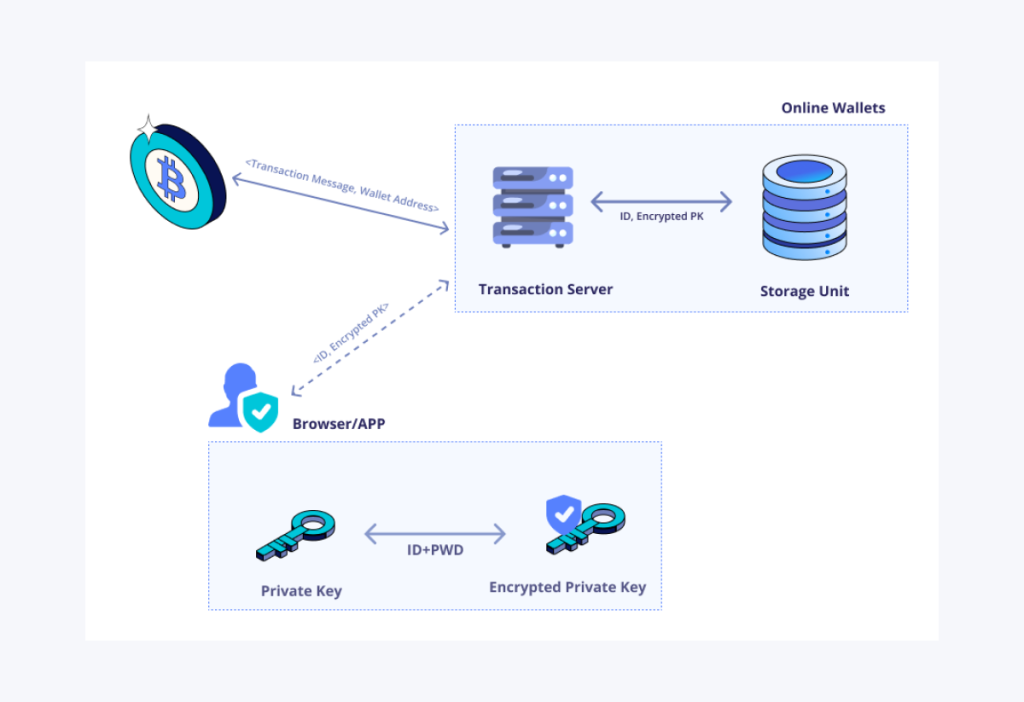
They can be mobile applications, desktop software, web browser plug-ins, or hardware devices. There are two types of wallets in accessibility and storage location:
- Hot wallets are connected online and used to conduct transfers.
- Cold wallets are offline storage where assets are safely stored.
If you want to create a crypto wallet app, you must also understand the difference between custodial and non-custodial wallets:
- Custodial wallets are controlled by a third party, a wallet provider, who gives users credentials to access and control their funds.
- Non-custodial wallets give users full control over their storage, including managing private and public keys and security settings.
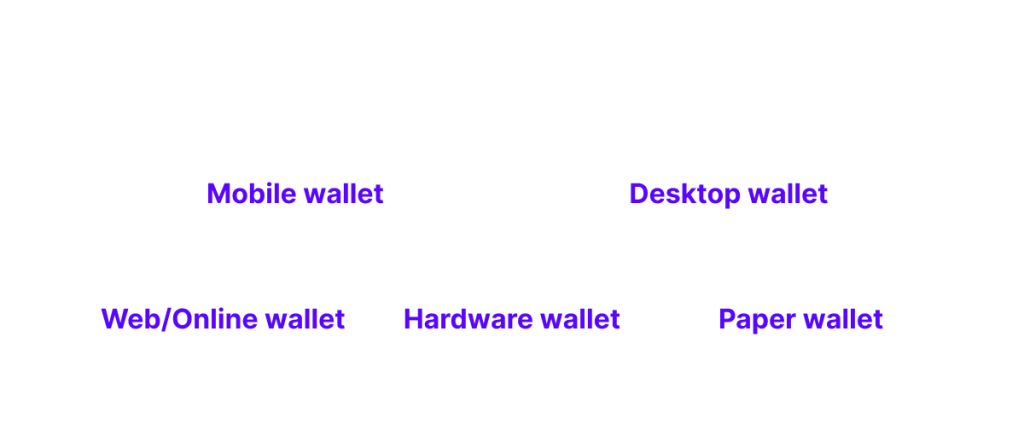
Individuals use DeFi wallets to transact in cryptocurrencies and interact with exchanges and NFT marketplaces, while businesses use them to automate crypto transactions, integrate dApps, and accept Bitcoin payments.
Fast Fact
Despite their outstanding safety, only 10% of users have a cold wallet due to their inconvenience.
Industry Overview
The crypto wallet market is growing exponentially due to the increasing adoption of digital currencies on the institutional and centralized levels.
According to Grand View Research, revenues from crypto wallets reached $12.5 billion in 2024, which is expected to reach $48 billion by 2030, growing at a 24.8% CAGR.
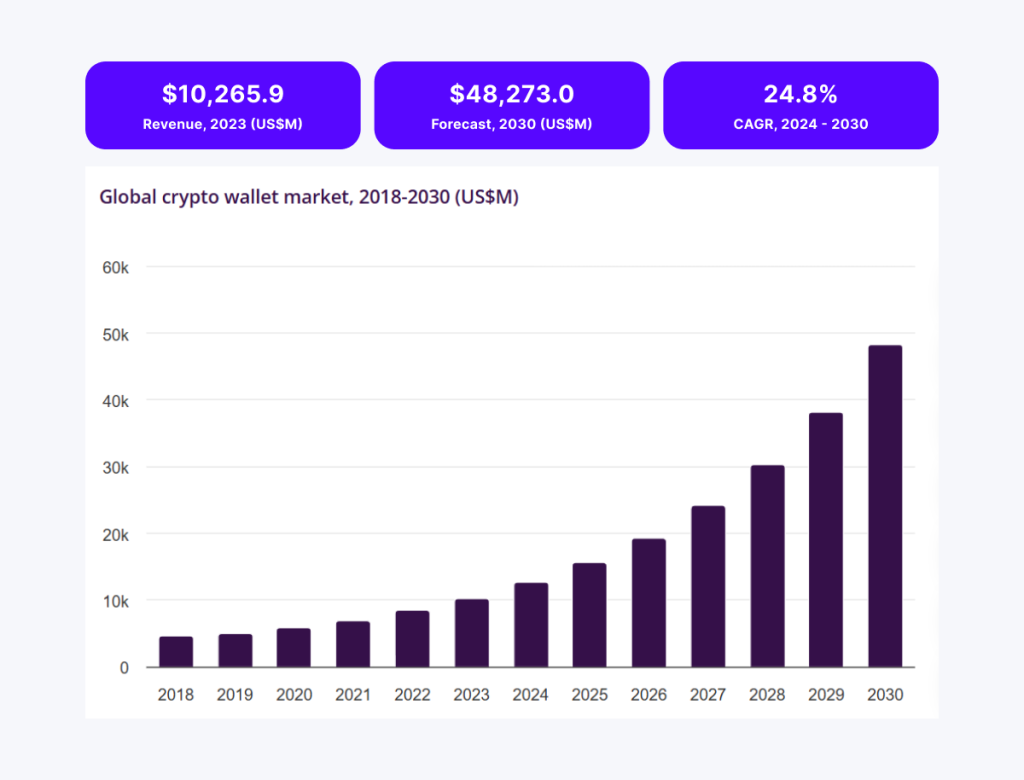
Much of these trends are attributed to the rising traders’ inflow to crypto-based ETFs, blockchain breakthroughs, and striking Bitcoin prices, which have accelerated this growth substantially.
The number of wallet users has increased massively. After the massive hike in 2021, then in 2022, over 750 million identity-verified crypto asset users are forecasted in 2025, with the potential to reach just under 1 billion users.

According to Chainalysis, the global crypto adoption index remains strong, with emerging markets leading this growth. Wallets are no longer just for storing value; they now facilitate staking, lending, and smart contract interactions. Popular wallets include MetaMask, Trust Wallet, and Ledger, catering to different security needs.

Security remains a significant challenge. Multi-signature wallets and hardware security modules (HSMs) are gaining popularity. Governments are also increasing regulatory scrutiny, with KYC (Know Your Customer) and AML (Anti-Money Laundering) compliance becoming standard for custodial wallets.
Create a Crypto Wallet App From Scratch
Building a crypto wallet from scratch involves custom coding, code writing, and full programming. It also gives you more control over features and service delivery. However, the process can be lengthy, resource-consuming and expensive.
This approach suits businesses that require unique functionalities and enhanced security and have specialized in-house teams to design, develop, and deploy the application from the ground up.
Ideally, you will need to implement blockchain integrations, support multiple cryptocurrencies and chain networks, ensure secure private key encryption, and provide flexible wallet management.
First-hand development allows you to integrate preferred security settings (2FA and biometrics), optimize application performance, and ensure legal compliance.
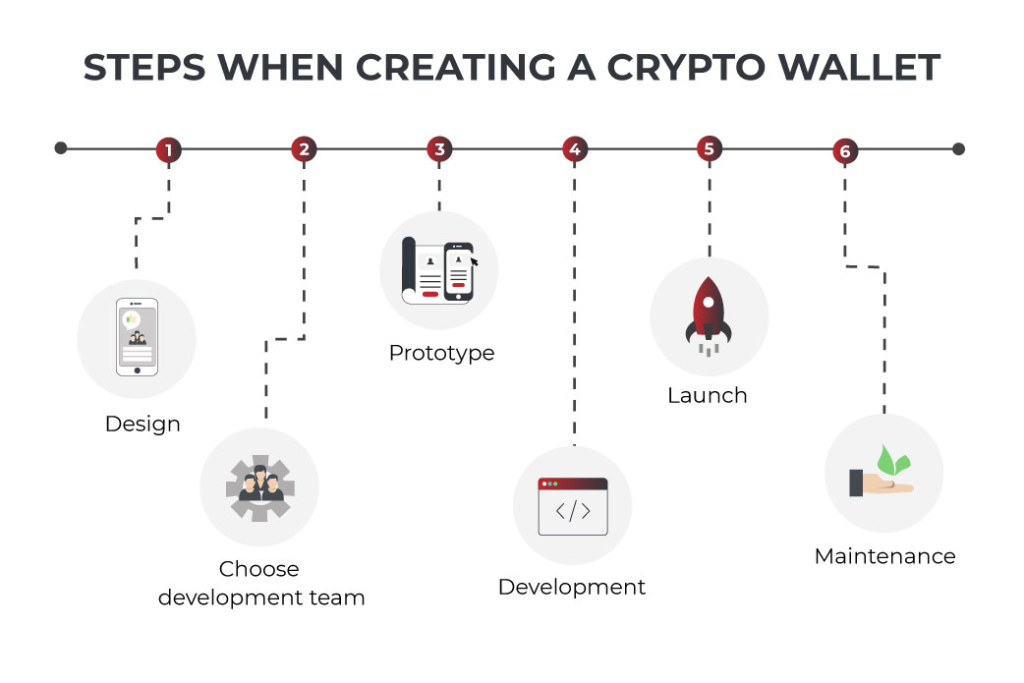
Cost Breakdown
In-house crypto wallet app development cost depends on features, security measures, and blockchain integrations. Therefore, you must determine your budget and align it with your business requirements.
- Hiring an experienced team of UI/UX designers. ($10,000 – $20,000)
- Hiring blockchain developers to secure blockchain integrations. ($20,000 – $50,000)
- Integrating with security software and conducting security audits. ($15,000 – $30,000)
- Hiring full-stack and software developers for the backend & APIs. ($25,000 – $60,000)
- Conducting QA tests, deploying and publishing your wallet app. ($10,000 – $25,000)
Total development costs can range from $80,000 to $200,000, excluding maintenance and regulatory compliance. Ongoing costs for server hosting, updates, and security patches add $10,000 – $30,000 per year.
Tech Stack
Creating a crypto wallet app entirely using internal teams requires several technologies and software needed for security, development, scalability, and blockchain interactions.
- Frontend development needs React.js or Vue.js for web apps and Swift or Kotlin for mobile apps, providing a smooth experience.
- The backend can be built with Node.js or Python to process transactions and manage authentication.
- Blockchain integrations using Ethereum, Bitcoin, or Solana APIs to enable secure transactions with different chains and currencies.
- Use PostgreSQL or MongoDB to store user databases and transaction data.
- Protect funds using AES encryption, multi-signature authentication, and Hardware Security Modules (HSM) for high-level security.
Advantages & Disadvantages
Building from scratch is ideal for large-scale businesses and enterprises needing a unique wallet solution. However, it may not be practical for startups due to cost and development time constraints.
Pros
- Full control over wallet features and services.
- High security with self-hosted private keys and management.
- More customization and scalability for enterprise-level solutions.
- Flexibility with advanced DeFi & multi-chain integrations.
Cons
- High recruiting, training, and development costs
- Requires blockchain-specific expertise and qualifications.
- Longer time to market (6-12 months), depending on complexity.
- Detailed security and regulatory implementation.
Development Steps
In-house development ensures control but requires high expertise, significant investment, and proper planning. Here is how you can start.
- Define wallet type, supported blockchains, and currencies.
- Plan UI/UX designs, onboarding, and transaction workflow.
- Integrate blockchain APIs and implement private key security.
- Ensure advanced encryption standards, multi-sig authentication, and conduct smart contract audits.
- Start backend and database development with transaction logs and secure data storage.
- Test your wallet, perform security audits, and resolve any performance issues.
- Deploy and publish your wallet on software/application stores and ensure regular maintenance.
Cryptocurrency Wallet Development Using Clone Script
A clone script is a pre-built wallet solution based on existing models like Trust Wallet or MetaMask. It allows businesses to launch a wallet quickly with minimal development efforts.
Clone scripting comes with pre-integrated features, such as multi-chain support, security layers, and DeFi integration. While cost-effective, there are some limitations pertaining to copyright issues, customization, and originality.
Creating a cryptocurrency wallet app using existing code scripts suits startups with limited workforce and businesses exploring new opportunities that require quick time-to-market deployment.

Cost Breakdown
Getting a script clone comes with various costs and licensing challenges. Some companies sell their own models for development and corporate use, while third-party marketplaces sell pre-built codes built on popular websites, such as Amazon and Binance. Here are some estimations.
- Finding, inspecting, and buying a suitable clone script license. ($5,000 – $20,000)
- Hiring developers to customize and reiterate the code to suit you. ($10,000 – $30,000)
- Hiring blockchain experts to manage blockchain integrations. ($10,000 – $25,000)
- Integrating top-notch security and fraud detection systems. ($10,000 – $20,000)
- Conducting testing rounds, quality assurance, and deployment. ($5,000 – $15,000)
Total costs range from $40,000 to $110,000, making it a cost-effective solution. However, ongoing maintenance and security updates may add $5,000 – $15,000 annually, depending on complexity and customization.
Tech Stack
While pre-developed infrastructure is less burdensome than complete development, you need an advanced technological stack to audit, update, redesign, and customize the script to your preferences.
- Frontend development typically uses React.js, Angular, or Vue.js for web apps and Swift or Kotlin for mobile apps.
- Backend development is powered by Node.js, Python, or Ruby on Rails, ensuring smooth server operations.
- Blockchain integration relies on Ethereum (via Web3.js or Ethers.js), Bitcoin, and Binance Smart Chain APIs for transactions.
- Databases like Firebase, PostgreSQL, or MongoDB are popular for storing wallet information securely.
- Security protocols like AES-256 encryption, JWT authentication, and multi-sig wallets should be reinforced for better protection.
Advantages & Disadvantages
Pre-built code scripts and models are more affordable and faster to deploy. However, there are some ups and downs that you must consider.
Pros
- Faster time to market, where you can launch in 2-3 months.
- Clone scripts are 50-70% cheaper than custom development.
- Pre-built codes come with tested security features and protocols.
- Flexibility with various cryptocurrencies and blockchain networks.
Cons
- Copied scripts can present limited customization and support.
- Code replicas may contain vulnerabilities and security gaps.
- Regulatory risks from copyright and licensing issues.
- Significant updates are required to address scalability needs.
Development Steps
Using a clone script is a faster and budget-friendly approach to launching your crypto wallet app, but it requires careful security compliance enhancements for different markets. Here’s how to do it.
- Find a reliable clone script provider and get a model that suits your business types (based on Trust Wallet or MetaMask)
- Customize the interfaces, colors, and logos to suit your brand.
- Verify security features and ensure a smooth user experience.
- Use blockchain APIs to support smart contract interactions.
- Implement biometric, multi-signature, and 2FA authentication.
- Test the prototype and launch your wallet app.
- Conduct regular code audits and updates to ensure compliance.
White-label Crypto Wallet App Development
White-label development is probably the most cost-efficient option for owning a customized Bitcoin wallet. This approach offers more flexibility in choosing the best crypto wallet app features and security settings.
White labels are pre-built platforms, similar to templates, offering core services and functionalities that can be further updated to align with your business objectives and requirements.
You can modify blockchain support, multi-currency transactions, DeFi integrations, and compliance with regulations more effortlessly. This model is ideal for startups and enterprises seeking faster deployment without compromising quality.
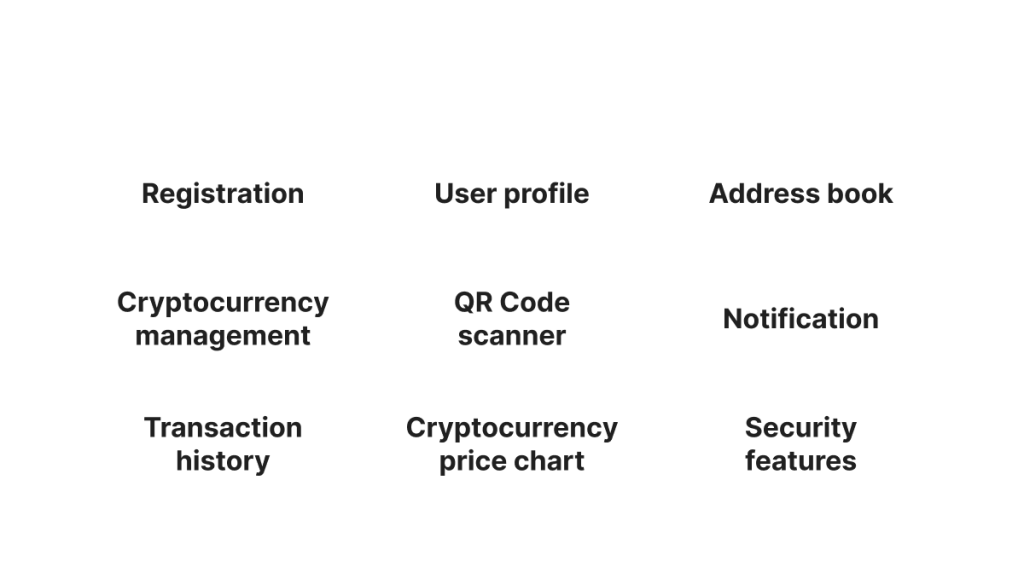
Cost Breakdown
The main costs associated with getting pre-built models are licensing, customization, and server maintenance. As such, you can save substantially on development from scratch. Here is an expected cost breakdown.
- Finding a suitable white-label provider and paying license fees. ($15,000 – $50,000)
- Customizing and rebranding with in-house UI/UX designers. ($20,000 – $40,000)
- Hiring blockchain developers and experts to manage integrations. ($15,000 – $35,000)
- Integrating solid security systems and fixing existing safety gaps. ($15,000 – $30,000)
- Ensuring regulatory compliance and integrating KYC verification. ($10,000 – $25,000)
- Developing and testing a beta version before full deployment. ($10,000 – $20,000)
Tech Stack
Developing your crypto wallet software using white-label requires less technical hassle. However, you need a team of developers to manage integrations and compatibility with existing systems.
Additionally, you must conduct frequent maintenance, audits, and updates to ensure optimum functionality. However, many providers offer a server maintenance service, saving time and money.
- Frontend builds use React or Angular for web apps and Swift or Kotlin for mobile apps, ensuring a user-friendly experience.
- The backend is typically powered by Node.js or Django. To handle transactions and security more seamlessly.
- Most turnkey wallets come with major blockchain integrations, so you may only need to modify or expand chain or currency support.
- Integrate KYC/AML compliance, advanced encryption, and multi-signature authentication to safeguard user funds and data.
Advantages & Disadvantages
White-label crypto wallet apps are more like plug-and-play solutions that offer a range of customization, security, and compliance, making them an ideal choice. However, you must be aware of some challenges.
Pros
- Faster deployment time in 3-4 months.
- Pre-built wallets support unique branding and customized UI/UX.
- Regulated white-label providers offer KYC/AML integrations.
- Most turnkey wallets are pre-integrated with main blockchains.
- High scalability and technical support for optimum functionality.
- Customizable security settings and wallet account management.
Cons
- Multiple recurring costs, including licensing and premium support.
- Limited security and customization control.
- Vendor dependence for system updates and service integrations.
- Regulatory requirements vary between regions and jurisdictions.
Development Steps
White-label wallets offer a fair balance of customization, security, compliance, and affordability, making them an excellent choice if you are entering the crypto ecosystem. Here’s how you can start.
- Find a reliable and regulated white-label provider that suits your build needs and budget requirements.
- Customize UI/UX designs, interfaces, and color schemes to suit your brand specifications.
- Establish blockchain integrations to support major chains, cryptocurrencies, and stablecoins.
- Implement top-notch security features, including biometric, 2-factor authentication, and multi-signature verifications.
- Integrate regulatory compliance and fraud detection software that adhere to KYC and AML protocols.
- Test and conduct quality assurance to ensure a smooth user experience and onboarding process.
- Launch your wallet and conduct regular maintenance and updates.
Conclusion
Developing a BTC wallet is a lucrative way to capitalize on the rising trends in crypto trading, institutional adoption, and technologies. However, there are multiple ways to create a crypto wallet app depending on your business size, requirements, and budget constraints.
You can hire a crypto wallet app development company to build from scratch, offering full control, but it is expensive. Clone scripts provide quick deployment at lower costs but with limited customization, while White-label solutions offer a perfect balance between branding and scalability.
Nevertheless, when developing a wallet application, you must include some of the key features like top security protocols, blockchain integrations, smooth user experience, flexible wallet management, and operational scalability.
FAQ
How much does developing a crypto wallet cost?
It depends on features, security, and blockchain integrations. White-label wallets offer a more cost-effective solution, starting at $80,000, with faster deployment and built-in compliance.
Is creating a custodial wallet better than non-custodial?
Custodial wallets provide easier access, security, and regulatory compliance, while non-custodial wallets give users full control over their funds but require more technical knowledge.
What crypto wallet type is more popular?
Non-custodial wallets are more popular among crypto enthusiasts due to full asset control, while custodial wallets dominate in exchanges and FinTech apps. White-label wallets are gaining traction, offering a customizable, secure solution in the crypto space.
What makes crypto wallet a successful business model?
There are multiple monetization models. Revenue comes from transaction fees, staking, DeFi integrations, and premium features. You can save on development costs using white-label solutions to boost your financials and see profitability sooner.



